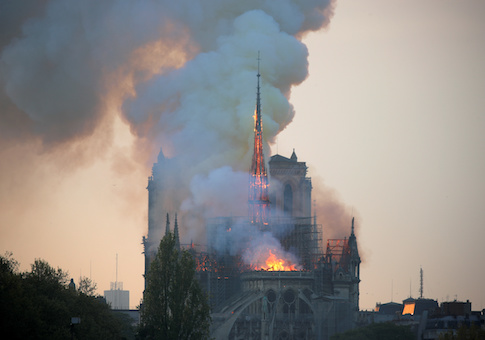I was intrigued today by the mystery of a small Jesus statue that features prominently in a New York Times story on Father Jean-Marc Fournier, the Paris Fire Department chaplain who risked his life to save many of Notre Dame cathedral's prized relics. "I had two priorities: to save the crown of thorns and a statue of Jesus," Father Fournier supposedly said.
The statue continues to star in the story:
As the chaplain began removing a statue of Jesus, he said, his colleagues were fighting the fire from the cathedral’s towers. The flames had started to threaten the wooden structure around the belfry — putting the whole cathedral at even greater risk.
With the statue in hand, Father Fournier, alone in the nave, gave a benediction to the cathedral, he said.
"I thought Jesus could help us a little bit and work, too," he said. "I invited him to worry about his own house if he didn’t want to finish the night under a tent by the Canal Saint-Martin."
Weirdly, there was no other reporting about Fournier saving a Jesus statue from Notre Dame. For that matter, Notre Dame cathedral doesn't even have a Jesus statue. He co-stars in the famous Pieta and a statue of the Virgin and Child (both unharmed), but neither could be lugged around by an elderly priest.
On the other hand, reporting on the ground indicated that Fournier saved "the Crown of Thorns and the Blessed Sacrament." CNN reports Fournier told them, "The police took the crown and I took the holy sacrament [the wafers, or body of Christ]." French-speakers can listen to Fournier telling his story to a French Catholic TV network, and again, he mentions saving the crown, the sacraments, and nothing else.
While the statue appeared in no other stories, the Times story was the only one not to mention the sacraments. I'm sure you see where this is going. Needless to say, there's now a correction indicating "an earlier version of this article misidentified one of two objects recovered from Notre-Dame by the Rev. Jean-Marc Fournier. It was the Blessed Sacrament, not a statue of Jesus."
How on earth could the Times make such a bizarre error? I suspect NY Post's Sohrab Ahmari, who first flagged this on Twitter, is correct: Fournier told the New York Times that he saved "the Body of the Christ" or some similar wording, and the Times misinterpreted that to mean a little statue of Jesus.
Hooooo boy. I figured this was common knowledge, but Christians do this thing once a week where, as one modern-day saint put it, we drink our little wine and eat our little cracker. We call the bread the "Body of Christ" and the wine the "Blood of Christ," a ceremony that dates back to the example Jesus himself set the night before he was crucified. Catholics in particular assign more importance to communion than most Protestants do, teaching that the bread becomes the literal body of Jesus Christ.
There's the possibility of some sort of translation error, but the Times reporter in question appears to be fluent in French. No, something was lost in translation alright, but I suspect that it was just a case of good-old fashioned religious illiteracy. The guy assigned to report on the biggest religion story of the day was really that ignorant of one of the most important ceremonies in the dominant religion on both sides of the Atlantic.
Ironically, the phrase "body of Christ" has led to this sort of mix-up before. The Washington Post's Kathleen Parker was horrified, just horrified that Ted Cruz said during a rally that "the body of Christ" should "rise up" to support him. "I don’t know anyone who takes their religion seriously who would think that Jesus should rise from the grave and resurrect himself to serve Ted Cruz," she complained.
For someone so versed in religion, Parker somehow didn't know that "body of Christ" is also a widely-used metaphor that means the Church as a whole. Cruz wanted Christians to vote for him, not for Jesus to rise from the grave and give him a thumbs-up. (Christians don't even believe that Jesus has a grave to resurrect himself from. We plan to celebrate that this Sunday. It's not a big deal, just sort of the basis of our entire religion.)
Is it really too much to ask that the pundits who weigh in on and the journalists who report on Christian matters know the first thing about Christianity? It's embarrassing when reporters botch stories on say, Judaism (like the AP reporter who thought Jews "sit and shiver"), but ignorance of the religious practices of 2% of Americans is at least somewhat understandable. The mainstream media has shown time and time against that they are ignorant of the basics of the deeply-held beliefs of a majority of their fellow Americans.
